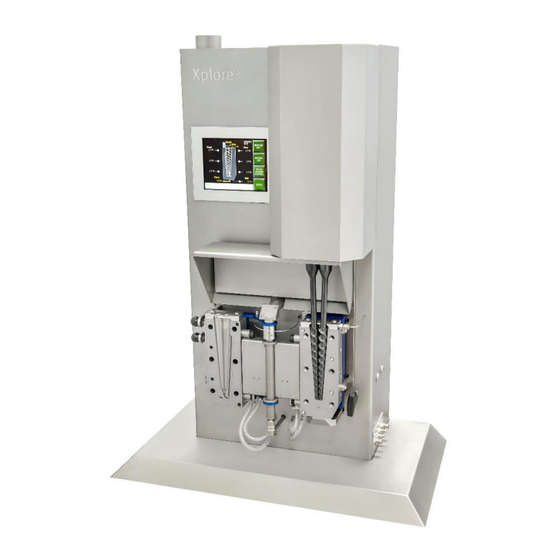
Table of Contents

Summarization of Contents
General Safety Rules
Before Getting Started
Identifies risks like burning, moving parts, and emphasizes safe operation.
The Most Important Risks
Highlights risks of touching hot parts and viscous materials, and general workplace safety.
Handling of Technical Safety Measures
Emphasizes training on emergency stops and safety features, forbidding bypass.
Introduction
General
Describes the intended use of MC 5 and MC 15 compounders for material development.
Target Group
Defines authorized and competent persons for manual use, operation, and maintenance.
Instrument Specifications
Details dimensions, heating, cooling, electrical system, and noise level of MC 5 and MC 15.
Options and Configurations
Outlines MC 5/MC 15 configurations, including Vari-Batch option for smaller batches.
Certification
States compliance with European Directives and applicable standards for the instrument.
Description of the Micro Compounder
General Operating Principle
Explains the basic working principle and components of the compounder's operation.
Description of the Electrical Circuit
Details the main and control current systems, including power supply and protection.
Safety Measures
Outlines general safety measures and risk minimization strategies for instrument operation.
Electrical Safety Features
Details safety features like fuses, interlocks, and protection for electrical systems.
Intrinsic Safety
Explains safety regarding moving parts, ensuring they are unlikely to be touched.
Vertical Force in the Compounder
Describes how vertical force indicates viscosity changes and protects against overload.
Emergency Stop
Explains the function and operation of the emergency stop switch for immediate shutdown.
Safety Measures for Co-Counter Configuration
Details extra safety for Co/Counter rotating screws, including switching and proper screw usage.
Covers and Safety Features
Covers moving parts with interlocks to prevent operation when open.
Personal Protection Equipment
Mandates specific PPE like protective clothing, safety shoes, gloves, and goggles.
Protection against Hot Parts
Warns about burn danger from high temperatures and describes housing cooling mechanisms.
Safety During Maintenance/Repair/Shutdown
Covers safety during maintenance, repair, and shutdown, including main switch usage.
Steps for Safe Lifting and Handling
Details procedures for safe lifting and moving the compounder, emphasizing proper gear.
Instructions
Recommends creating working instructions and holding briefing meetings for safety.
Safety Measures for Working with Dangerous Substances
Addresses safe handling of dangerous substances, including exhaust systems and PPE.
Ergonomics
Explains ergonomic considerations in the design for operator comfort and efficient workstation setup.
Options and Extras
Vari-Batch® Option
Allows processing of very small quantities by adjusting batch volume with inserts.
Co-Counter Rotating
Enables switching screw rotation direction for different mixing efficiencies.
Temperature Adjustment Range Above 400 °C
Optional upgrade to 450 °C maximum processing temperature for specific materials.
Force Range for the MC 15 up to 9500 N
Option for MC 15 to increase downward force limit to 9500 N for processing more products.
Film Device
Describes coupling of film lines for producing continuous flat foil of various widths.
Setup, Installation, and Adjustment
Preparations
Covers unpacking, keeping packaging for warranty, and checking for damage.
Installation
Provides guidance on placing the manual and ensuring all parts are correctly installed before operation.
Setup
Details the setup process, including heated housing and screw rotation speed adjustment.
Working with the Instrument
Operation
Explains how to operate the compounder using the touch screen interface and its control system.
Software
Software Overview
Details PC connectivity via USB, data acquisition, automated cycles, and system requirements.
Installation of the Software Program
Guides through CD-ROM installation using InstallShield Wizard, including version compatibility.
Xplore PC Software
Explains PC connection, selecting control mode, and software detection of the compounder.
About Screen
Provides general information about the Compounder and Xplore in the PC software.
Process Status Screen Details
Shows current processing values and settings; mirrors touch screen but does not allow changes.
Settings Screen Details
Allows control of heating, force, and speed via PC when in PC mode.
Program Screen Details
Enables creation, saving, and loading of programs for polymer formulations and process cycles.
Cleaning Screen Details
Enables design, saving, and loading of cleaning cycles with compound and barrel rotation.
Graph Screen Details
Represents process parameters graphically versus time, allowing selection of displayed data.
General Use of the Compounder
General
Outlines general starting conditions required for compounder operation, including safety checks.
Stopping, Emergency Stop, Shutdown, and Isolation
Details procedures for emergency stops, shutdown, and disconnecting energy supply.
Cleaning
Provides safety requirements for cleaning the instrument exterior and interior, including barrel cleaning.
Cleaning of the Compounder
Details opening, screw handling, barrel cleaning, and closing procedures.
Testing and Inspection
Outlines daily functional testing and visual inspection procedures for safety and operation.
Faults and Repairs
Describes fault messages, causes, solutions, and general/technical fault resolution.
Filling of the Compounder
Details heating, hopper connection, and the process of filling with viscous material.
Compounding
Explains performing compounding after filling and closing, including draining and repeating cycles.
The Mounting of the Screws
Details screw attachment for Co/Counter rotating, including lubrication and torque.
Maintenance
General
Emphasizes maintenance importance and warns against self-replacement of parts.
Daily Maintenance
States no daily maintenance is required but recommends cleaning at day's end.
Weekly Maintenance
Covers checking hoses, cables, and screw lubrication by competent persons.
Monthly Maintenance
Focuses on checking water cooling for lime build-up by competent persons.
Maintenance of Electrical Installation
Details electrical system maintenance: filters, connections, safety devices, and protection.
Scrapping and Environment
Demolishing
States that waste processing rules must be followed, and customer is responsible for part disposal.
Recycling
Notes that most parts are steel/aluminium and can be scrapped as old metal.

Need help?
Do you have a question about the 2015 and is the answer not in the manual?
Questions and answers